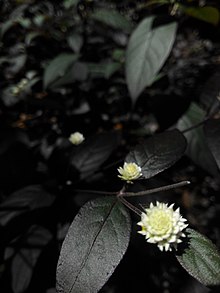Alternanthera

Alternanthera is a genus of flowering plants in the family Amaranthaceae. It is a widespread genus with most species occurring in the tropical Americas,[1][2] and others in Asia, Africa, and Australia.[2] Plants of the genus may be known generally as joyweeds, or Joseph’s coat.[3] Several species are notorious noxious weeds.[4]
These are annual or perennial herbs or subshrubs. While some of the better-known species are aquatic plants, most are terrestrial.[4] They take many forms, from prostrate to erect to floating. The leaves are oppositely arranged. The inflorescence is a spike or a rounded head occurring in the leaf axils or the ends of branches. The flowers have 5 tepals. There are 3 to 5 stamens which are fused into a rim at the bases, and 5 pseudostaminodes, appendages between the stamens that are not true staminodes. The fruit is a utricle containing one seed.[2]
The genus Alternanthera contains both terrestrial and aquatic species. The photosynthetic pathway varies in this genus: Some species undergo C3 carbon fixation, one clade of 17 species has acquired the C4 pathway, and yet other species have an intermediate C3-C4 pathway.[5][1][6]
Many species have been reported as noxious weeds, including A. angustifolia, A. caracasana, A. denticulata, A. nana, A. nodiflora, A. paronychioides, A. philoxeroides, A. sessilis, A. tenella, and A. triandra.[4] The most important species is alligator weed (A. philoxeroides), a South American aquatic plant that has spread to other continents.[4] It is a weed of many kinds of agricultural crops, it is an invasive species that degrades native habitat, and its dense mats of vegetation clog waterways, slowing shipping and increasing flooding.[4] Alternanthera plants are known to produce allelopathic compounds that injure other plants, including crops.[4]
Biological pest control agents now in use to reduce alligator weed infestations include the alligator weed flea beetle (Agasicles hygrophila), the alligator weed thrips (Amynothrips andersoni), and the alligator weed stem borer (Arcola malloi).[4]
